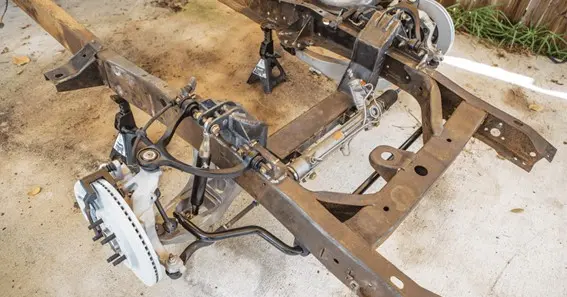Swapping a Crown Victoria Independent Front Suspension (IFS) into classic trucks and cars has become a popular modification among automotive enthusiasts. This upgrade offers improved handling, braking, and ride quality. However, selecting the best Crown Vic IFS for your swap requires careful consideration of model years, compatibility, and installation nuances.
Understanding the Crown Vic IFS
The Ford Crown Victoria, produced from 1992 to 2011, features a robust and well-engineered IFS unit. Notably, the 2003-2011 models come with an aluminum crossmember, making them lighter and more desirable for swaps. This front-end assembly includes components such as control arms, spindles, brakes, and a rack-and-pinion steering system, all mounted on a single subframe.
Why Choose the 2003-2011 Crown Vic IFS for Swaps?
- Aluminum Crossmember: The aluminum construction reduces weight, enhancing vehicle performance and fuel efficiency.
- Improved Geometry: These models offer better suspension geometry, leading to superior handling characteristics.
- Availability: The 2003-2011 Crown Vics are relatively common, making parts more accessible and affordable.
Compatibility Considerations
Before proceeding with the swap, assess the compatibility of the Crown Vic IFS with your vehicle:
- Frame Width: The Crown Vic IFS is approximately 34 inches wide between the mounting pads. Ensure your vehicle’s frame can accommodate this width or be modified accordingly.
- Track Width: The track width of the Crown Vic IFS is wider than many classic vehicles. This may require adjustments to wheel offset or fender modifications to achieve the desired stance.
- Engine Mounts: The IFS does not come with engine mounts. You’ll need to fabricate or purchase mounts compatible with your engine and the new suspension setup.
Installation Tips
- Frame Preparation: Reinforce and box the frame rails where the IFS will mount to ensure structural integrity.
- Alignment: Precisely measure and align the IFS to prevent issues like “dog tracking” or uneven tire wear.
- Steering Integration: Adapt the steering column to connect with the Crown Vic’s rack-and-pinion system. This may involve using universal joints or custom shafts.
- Brake System: Integrate the Crown Vic’s braking system with your vehicle, ensuring compatibility of master cylinders and proportioning valves.
- Wheel and Tire Selection: Choose wheels with appropriate offset to accommodate the wider track width and prevent clearance issues.
Pros and Cons of the Crown Vic IFS Swap
Pros:
- Enhanced handling and ride quality.
- Modern braking system with disc brakes.
- Availability of parts and aftermarket support.
Cons:
- Potential width issues requiring frame or body modifications.
- Fabrication skills needed for proper installation.
- Possible challenges in integrating steering and braking systems.
FAQ
1. What vehicles are suitable for a Crown Vic IFS swap?
The Crown Vic IFS is commonly swapped into classic Ford trucks (F-100, F-150) and other vintage vehicles with compatible frame widths.
2. Do I need to modify my vehicle’s frame for the swap?
Yes, modifications such as boxing the frame and ensuring proper mounting points are typically required for a safe and effective installation.
3. Can I retain my vehicle’s original steering column?
You can often retain the original steering column, but it will need to be adapted to connect with the Crown Vic’s rack-and-pinion system.
4. Is professional installation recommended?
If you lack fabrication experience, professional installation is advisable to ensure safety and proper alignment.
5. How does the swap affect the vehicle’s ride height?
The swap can lower the vehicle’s ride height. Adjustments to springs or spacers may be necessary to achieve the desired stance.
In conclusion, selecting the best Crown Vic IFS for your swap involves choosing the 2003-2011 models for their advantageous features. Careful planning and execution of the installation will result in a significant enhancement to your vehicle’s performance and handling.








